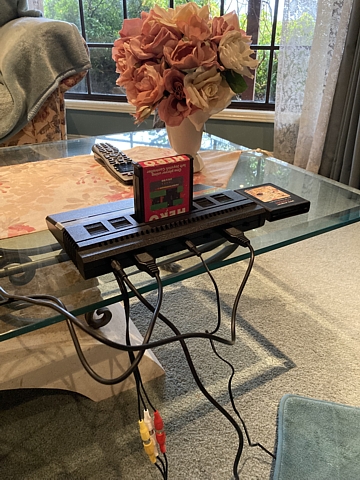
Atari 2600 Video Computer System, 'Junior' version
This later version of the Atari 2600 was released towards the end of the Second Generation of Video Games. More compact and less expensive than previous models (though functionally unchanged) it became known as the 'Junior'

A new type of controller was included, featuring a mini joystick / D pad control and two buttons, which was interchangeable with earlier model controllers.
This particular unit was without any controllers when purchased but also works with the original 'Paddle' controllers (1 pair seen here) which were originally intended for Pong style games. Each pair of Paddle controllers plugs into 1 port on the console, allowing paddle games to support up to 4 players.
Atari 'Paddle' Games
Action Man Action Force
Astroblast
Backgammon
Breakout
Casino
Circus Atari
Demons to Diamonds
Kaboom!
Night Driver
Star Wars: Jedi Arena
Video Olympics (Pong)
Warlords*
I've been asked to add an AV output modification to an Atari 2600 'Junior' console so it can be used with a modern television with digital only tuner. There would be a number of ways to connect these units including upscaling, analog to digital video converters but in my opinion the simplest option is usually best.
Almost all TVs still include analog composite AV inputs so a little modification to the Atari console can tap into the video and audio signals just prior to its RF modulator. There are plenty of well documented examples of similar modifications having been done before so there is no need to 'reinvent the wheel'.
Some of the modifications seem a little extreme, removing a number of components and disabling the original analog RF output completely. I prefer to retain original components and features wherever possible so intend to leave this section intact and simply add an AV output as per an example found online (link below).

To keep it neat I've installed the components to the solder side of the PCB, seen here before refitting the metal shield and also added a pair of 10k Ohm resistors in series with the two audio output cables. This reduces the volume slightly and results in a better match for the sound levels when switching between the RF and AV outputs.
More importantly, the resistors would also help to protect the TIA IC in the console, should the external audio connection be short circuited at any time. Without them, the audio output from the IC would be directly connected to the external load.
Testing the AV modification on the bench, using my 34cm NEC TV shows a marked improvement from the RF output to the AV signal. Admittedly, at this stage the metal RF shield plate has not been refitted, increasing the noise level of the RF signal somewhat.

Above, the console's original RF output signal and below, the AV composite Video signal quality, both as seen on the analog 34cm NEC CRT TV.

The console reassembled and AV output cable routed just below the original RF output socket, I've enlarged the panel cutout just enough to allow the cable to pass through after refitting the metal shield and adding some strain relief internally.

Rather than panel mounting AV sockets which would require extensive modification to the console's plastic case I've used a short cable with inline RCA sockets. I've also included a 3m, 3 x RCA plug to plug AV lead to connect from there to the TVs AV input.

Modifications complete and time to test the final result on the 39" LCD lounge room TV, compared to the console's original unmodified state.

Above, this photo taken upon initial testing prior to any modification being carried out, showing the console's original RF output signal connected via a VCR analog RF input. Below, the AV composite Video signal quality, connected via a HDD recorder front panel AV input.

As seen above the AV signal is much cleaner but there is still some patterning especially at the transition between colours - which is a limitation of the composite video format.
It's far from a high definition image but keeping in mind these original machines would have been viewed on much smaller, low resolution CRT screens (such as my bench testing TV) still quite acceptable.
To me, the whole point of using original hardware as opposed to modern emulation products is to recall the original experience as closely as possible. With minimal modification this original Atari system can still be used and enjoyed, even in a modern setting and connected to a larger, LCD TV.
Web Resources (External Links) -
ATARI 2600 Junior Composite Mod - Console Corner
All images and text on this website are Copyright.
Contact: jbtech at telstra dot com